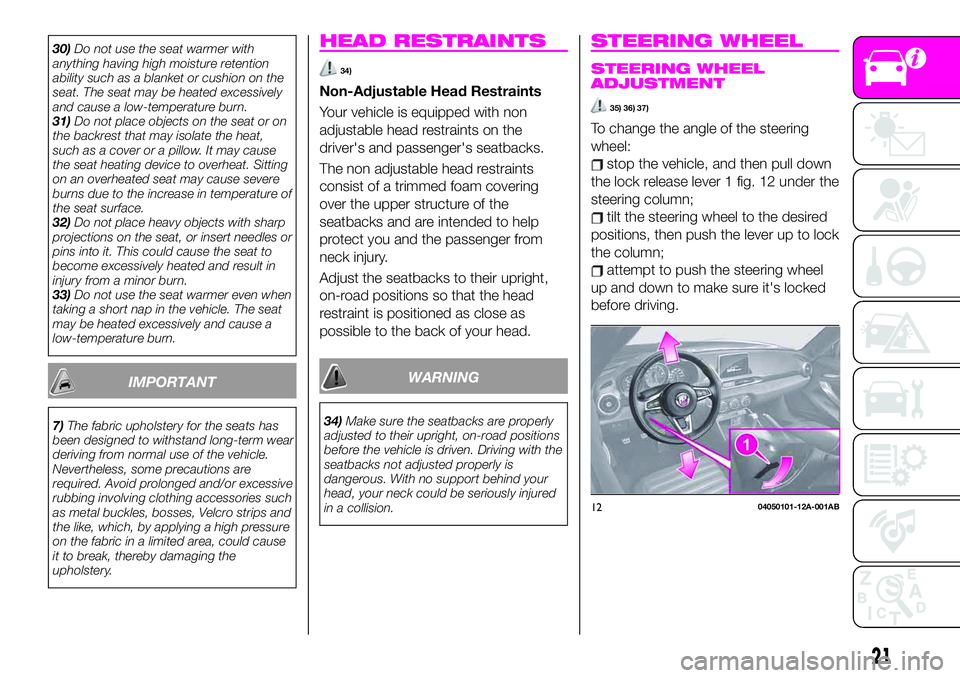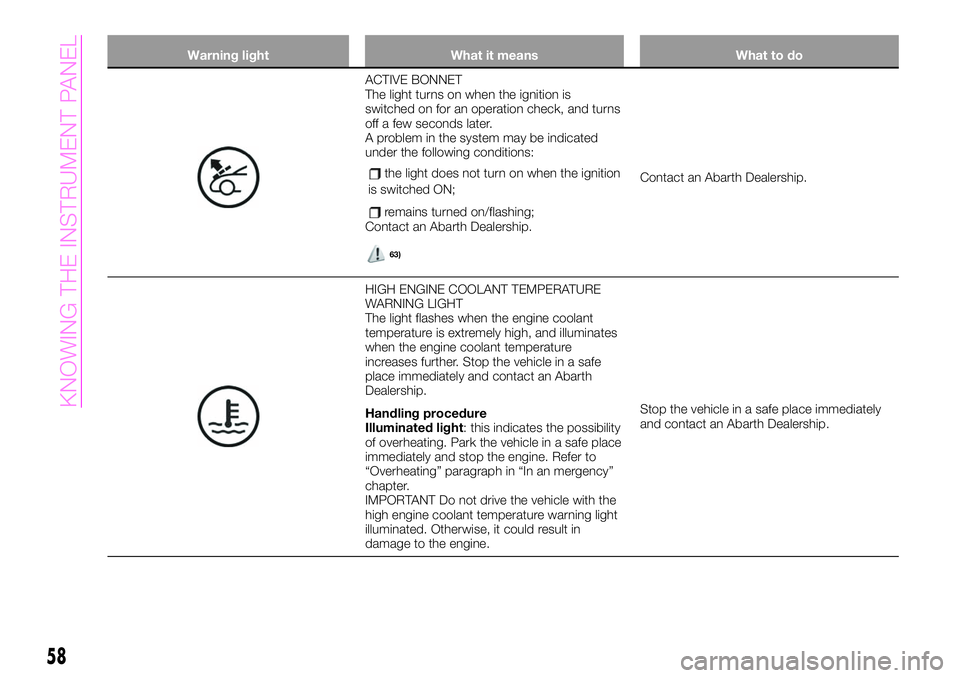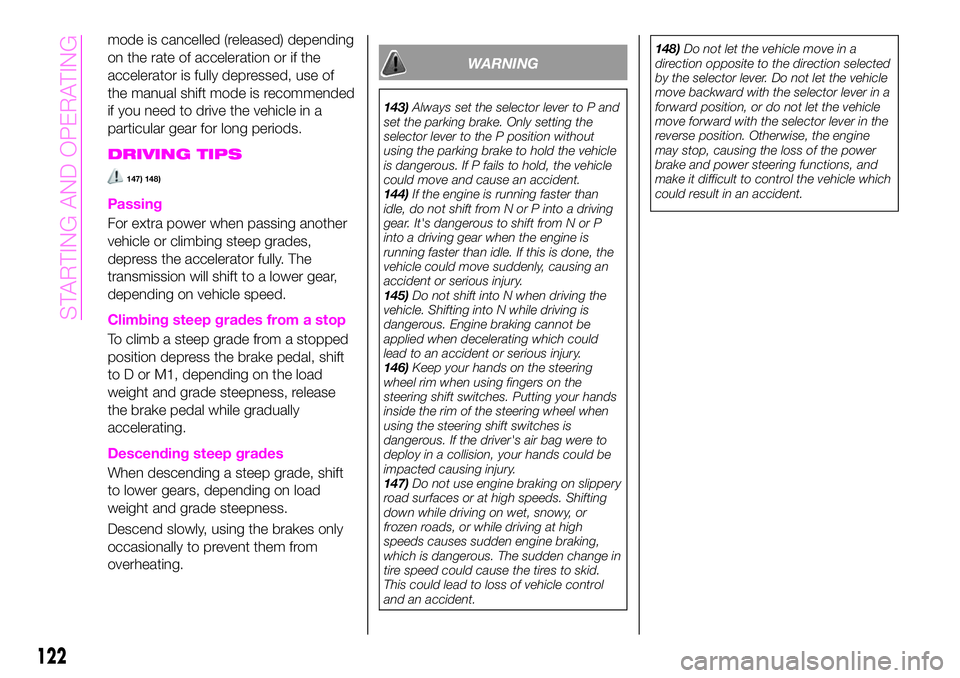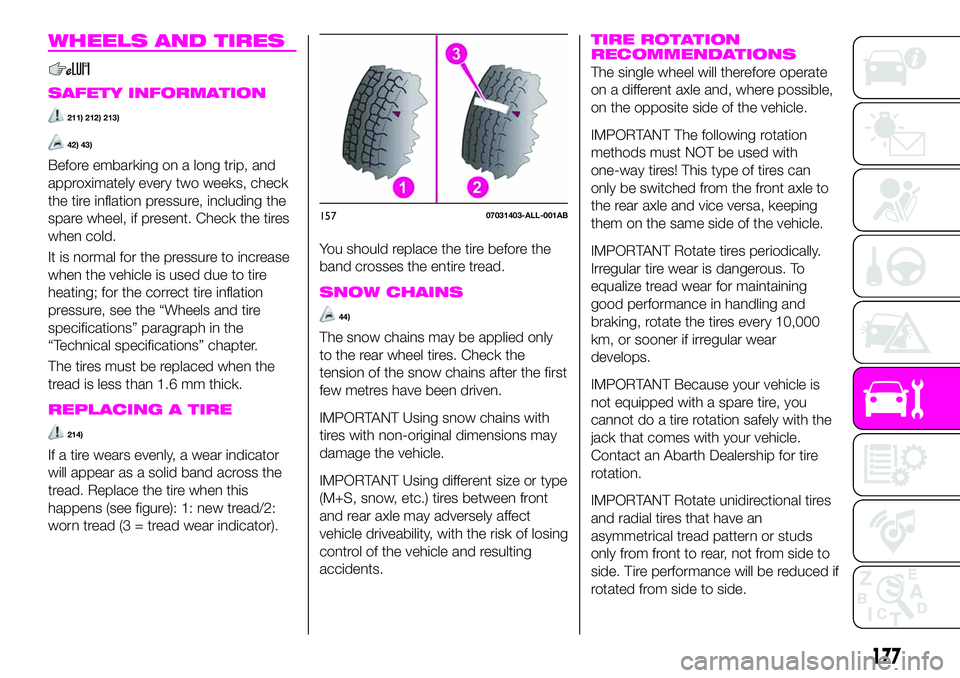heating Abarth 124 Spider 2020 Owner handbook (in English)
[x] Cancel search | Manufacturer: ABARTH, Model Year: 2020, Model line: 124 Spider, Model: Abarth 124 Spider 2020Pages: 224, PDF Size: 3.9 MB
Page 23 of 224

30)Do not use the seat warmer with
anything having high moisture retention
ability such as a blanket or cushion on the
seat. The seat may be heated excessively
and cause a low-temperature burn.
31)Do not place objects on the seat or on
the backrest that may isolate the heat,
such as a cover or a pillow. It may cause
the seat heating device to overheat. Sitting
on an overheated seat may cause severe
burns due to the increase in temperature of
the seat surface.
32)Do not place heavy objects with sharp
projections on the seat, or insert needles or
pins into it. This could cause the seat to
become excessively heated and result in
injury from a minor burn.
33)Do not use the seat warmer even when
taking a short nap in the vehicle. The seat
may be heated excessively and cause a
low-temperature burn.
IMPORTANT
7)The fabric upholstery for the seats has
been designed to withstand long-term wear
deriving from normal use of the vehicle.
Nevertheless, some precautions are
required. Avoid prolonged and/or excessive
rubbing involving clothing accessories such
as metal buckles, bosses, Velcro strips and
the like, which, by applying a high pressure
on the fabric in a limited area, could cause
it to break, thereby damaging the
upholstery.
HEAD RESTRAINTS
34)
Non-Adjustable Head Restraints
Your vehicle is equipped with non
adjustable head restraints on the
driver's and passenger's seatbacks.
The non adjustable head restraints
consist of a trimmed foam covering
over the upper structure of the
seatbacks and are intended to help
protect you and the passenger from
neck injury.
Adjust the seatbacks to their upright,
on-road positions so that the head
restraint is positioned as close as
possible to the back of your head.
WARNING
34)Make sure the seatbacks are properly
adjusted to their upright, on-road positions
before the vehicle is driven. Driving with the
seatbacks not adjusted properly is
dangerous. With no support behind your
head, your neck could be seriously injured
in a collision.
STEERING WHEEL
STEERING WHEEL
ADJUSTMENT
35) 36) 37)
To change the angle of the steering
wheel:
stop the vehicle, and then pull down
the lock release lever 1 fig. 12 under the
steering column;
tilt the steering wheel to the desired
positions, then push the lever up to lock
the column;
attempt to push the steering wheel
up and down to make sure it's locked
before driving.
1204050101-12A-001AB
21
Page 60 of 224

Warning light What it means What to do
ACTIVE BONNET
The light turns on when the ignition is
switched on for an operation check, and turns
off a few seconds later.
A problem in the system may be indicated
under the following conditions:
the light does not turn on when the ignition
is switched ON;
remains turned on/flashing;Contact an Abarth Dealership.
63)
Contact an Abarth Dealership.
HIGH ENGINE COOLANT TEMPERATURE
WARNING LIGHT
The light flashes when the engine coolant
temperature is extremely high, and illuminates
when the engine coolant temperature
increases further. Stop the vehicle in a safe
place immediately and contact an Abarth
Dealership.
Handling procedure
Illuminated light: this indicates the possibility
of overheating. Park the vehicle in a safe place
immediately and stop the engine. Refer to
“Overheating” paragraph in “In an mergency”
chapter.
IMPORTANT Do not drive the vehicle with the
high engine coolant temperature warning light
illuminated. Otherwise, it could result in
damage to the engine.Stop the vehicle in a safe place immediately
and contact an Abarth Dealership.
58
KNOWING THE INSTRUMENT PANEL
Page 124 of 224

mode is cancelled (released) depending
on the rate of acceleration or if the
accelerator is fully depressed, use of
the manual shift mode is recommended
if you need to drive the vehicle in a
particular gear for long periods.
DRIVING TIPS
147) 148)
Passing
For extra power when passing another
vehicle or climbing steep grades,
depress the accelerator fully. The
transmission will shift to a lower gear,
depending on vehicle speed.
Climbing steep grades from a stop
To climb a steep grade from a stopped
position depress the brake pedal, shift
to D or M1, depending on the load
weight and grade steepness, release
the brake pedal while gradually
accelerating.
Descending steep grades
When descending a steep grade, shift
to lower gears, depending on load
weight and grade steepness.
Descend slowly, using the brakes only
occasionally to prevent them from
overheating.
WARNING
143)Always set the selector lever to P and
set the parking brake. Only setting the
selector lever to the P position without
using the parking brake to hold the vehicle
is dangerous. If P fails to hold, the vehicle
could move and cause an accident.
144)If the engine is running faster than
idle, do not shift from N or P into a driving
gear. It's dangerous to shift from N or P
into a driving gear when the engine is
running faster than idle. If this is done, the
vehicle could move suddenly, causing an
accident or serious injury.
145)Do not shift into N when driving the
vehicle. Shifting into N while driving is
dangerous. Engine braking cannot be
applied when decelerating which could
lead to an accident or serious injury.
146)Keep your hands on the steering
wheel rim when using fingers on the
steering shift switches. Putting your hands
inside the rim of the steering wheel when
using the steering shift switches is
dangerous. If the driver's air bag were to
deploy in a collision, your hands could be
impacted causing injury.
147)Do not use engine braking on slippery
road surfaces or at high speeds. Shifting
down while driving on wet, snowy, or
frozen roads, or while driving at high
speeds causes sudden engine braking,
which is dangerous. The sudden change in
tire speed could cause the tires to skid.
This could lead to loss of vehicle control
and an accident.148)Do not let the vehicle move in a
direction opposite to the direction selected
by the selector lever. Do not let the vehicle
move backward with the selector lever in a
forward position, or do not let the vehicle
move forward with the selector lever in the
reverse position. Otherwise, the engine
may stop, causing the loss of the power
brake and power steering functions, and
make it difficult to control the vehicle which
could result in an accident.
122
STARTING AND OPERATING
Page 179 of 224

WHEELS AND TIRES
SAFETY INFORMATION
211) 212) 213)
42) 43)
Before embarking on a long trip, and
approximately every two weeks, check
the tire inflation pressure, including the
spare wheel, if present. Check the tires
when cold.
It is normal for the pressure to increase
when the vehicle is used due to tire
heating; for the correct tire inflation
pressure, see the “Wheels and tire
specifications” paragraph in the
“Technical specifications” chapter.
The tires must be replaced when the
tread is less than 1.6 mm thick.
REPLACING A TIRE
214)
If a tire wears evenly, a wear indicator
will appear as a solid band across the
tread. Replace the tire when this
happens (see figure): 1: new tread/2:
worn tread (3 = tread wear indicator).You should replace the tire before the
band crosses the entire tread.
SNOW CHAINS
44)
The snow chains may be applied only
to the rear wheel tires. Check the
tension of the snow chains after the first
few metres have been driven.
IMPORTANT Using snow chains with
tires with non-original dimensions may
damage the vehicle.
IMPORTANT Using different size or type
(M+S, snow, etc.) tires between front
and rear axle may adversely affect
vehicle driveability, with the risk of losing
control of the vehicle and resulting
accidents.
TIRE ROTATION
RECOMMENDATIONS
The single wheel will therefore operate
on a different axle and, where possible,
on the opposite side of the vehicle.
IMPORTANT The following rotation
methods must NOT be used with
one-way tires! This type of tires can
only be switched from the front axle to
the rear axle and vice versa, keeping
them on the same side of the vehicle.
IMPORTANT Rotate tires periodically.
Irregular tire wear is dangerous. To
equalize tread wear for maintaining
good performance in handling and
braking, rotate the tires every 10,000
km, or sooner if irregular wear
develops.
IMPORTANT Because your vehicle is
not equipped with a spare tire, you
cannot do a tire rotation safely with the
jack that comes with your vehicle.
Contact an Abarth Dealership for tire
rotation.
IMPORTANT Rotate unidirectional tires
and radial tires that have an
asymmetrical tread pattern or studs
only from front to rear, not from side to
side. Tire performance will be reduced if
rotated from side to side.
15707031403-ALL-001AB
177